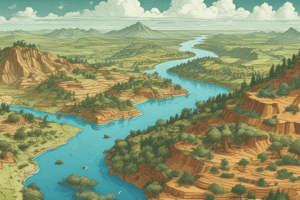Podcast
Questions and Answers
What is the main focus of land cover classification within remote sensing?
What is the main focus of land cover classification within remote sensing?
- Exploring underwater ecosystems
- Identifying and categorizing surface features of Earth (correct)
- Monitoring atmospheric changes
- Tracking space debris
Which type of remote sensing uses reflected or emitted energy from the Earth's surface?
Which type of remote sensing uses reflected or emitted energy from the Earth's surface?
- Aerial remote sensing
- Passive remote sensing (correct)
- Ground-based remote sensing
- Active remote sensing
How does remote sensing contribute to evaluating the implications of land management decisions?
How does remote sensing contribute to evaluating the implications of land management decisions?
- Through direct observation by researchers on the ground
- By analyzing data from social media platforms
- By conducting surveys among local residents
- By utilizing satellite imagery and other remote sensing data sources (correct)
Which remote sensing platform is specifically mentioned as an example of passive remote sensing in the text?
Which remote sensing platform is specifically mentioned as an example of passive remote sensing in the text?
What is the main difference between supervised and unsupervised classification methods in land cover classification?
What is the main difference between supervised and unsupervised classification methods in land cover classification?
What is the primary function of active remote sensing satellites?
What is the primary function of active remote sensing satellites?
In land cover classification, which technique uses laser pulses to measure distances between the sensor and the Earth's surface?
In land cover classification, which technique uses laser pulses to measure distances between the sensor and the Earth's surface?
How does semi-supervised classification differ from supervised and unsupervised classification methods?
How does semi-supervised classification differ from supervised and unsupervised classification methods?
Which land cover classification method processes images by identifying coherent objects based on spatial, spectral, and textural properties?
Which land cover classification method processes images by identifying coherent objects based on spatial, spectral, and textural properties?
Why is land cover classification data valuable in water management applications?
Why is land cover classification data valuable in water management applications?
Flashcards are hidden until you start studying
Study Notes
Remote Sensing: Exploring Land Cover Classification
Remote sensing is a vital field that leverages various technologies to collect, analyze, and interpret data about Earth's surface, atmosphere, and phenomena. One of the most impactful subtopics within remote sensing is land cover classification, which focuses on identifying, mapping, and intelligently categorizing land features in Earth's ecosystems.
Land Cover Classification: An Essential Concept
Land cover classification is the process of identifying and categorizing the surface features of Earth, such as forests, grasslands, cities, and water bodies. This method is essential for understanding the distribution and change of Earth's land cover over time. Remote sensing data, obtained from aerial imagery, satellites, and other sources, helps researchers evaluate the ecological, environmental, and socioeconomic implications of land management decisions.
Remote Sensing Techniques and Platforms
Land cover classification can be executed using a wide range of remote sensing techniques and platforms:
-
Passive remote sensing: This method uses reflected or emitted energy from the Earth's surface, captured by sensors in visible, near-infrared, shortwave-infrared, or thermal bands. Examples include Landsat, Sentinel-2, and MODIS satellites.
-
Active remote sensing: These sensors emit energy in the form of radar signals to map specific landforms, such as topography, vegetation structure, or soil moisture. Examples include Sentinel-1 and RADARSAT-2 satellites.
-
Airborne remote sensing: This technique involves collecting data from aircraft or unmanned aerial vehicles (UAVs) to gain higher spatial resolution and acquire detailed imagery of specific areas.
-
LiDAR (Light Detection and Ranging): This technique uses laser pulses to measure the distance between the sensor and the Earth's surface, providing detailed topographic and bathymetric data.
-
Thermal imaging: This method detects thermal emissions from the Earth's surface to measure the distribution of heat, which can help identify unique land cover types, such as warm-water bodies or urban heat islands.
Common Land Cover Classification Methods
There are several methods for achieving land cover classification, including:
-
Supervised classification: This method uses predefined classes and training data to classify new data through machine learning algorithms.
-
Unsupervised classification: This method clusters pixels based on their inherent similarities and differences, without prior classification knowledge.
-
Semi-supervised classification: This method combines supervised and unsupervised classification techniques, using both predefined classes and data-driven clusters.
-
Object-based image analysis: This method processes images in an object-oriented manner, identifying and categorizing coherent objects based on their spatial, spectral, and textural properties.
-
Deep learning: This method employs artificial neural networks to automatically classify land cover data, generating more accurate and robust results than traditional methods.
Applications and Benefits of Land Cover Classification
Land cover classification data is invaluable in numerous applications, including:
- Environmental monitoring: Assessing land cover can help detect deforestation, urbanization, and other land-use changes that impact ecosystems and natural systems.
- Disaster management: Identifying land cover allows for better hazard assessment, response planning, and tracking post-disaster recovery.
- Climate research: Analyzing land cover can help estimate greenhouse gas emissions, evaluate carbon sequestration, and study land-atmosphere interactions.
- Water management: Accurate land cover classification can help identify water bodies and wetlands, enabling better water resource management and conservation.
- Agricultural monitoring: Land cover data can help assess crop yields, detect crop health, and monitor the spread of agricultural practices.
- Land-use planning: Accurate land cover classification allows for informed decision-making in urban planning, transportation, and infrastructure development.
Conclusion
Land cover classification is a critical subtopic in remote sensing, with numerous applications in environmental monitoring, disaster management, climate research, water management, agricultural monitoring, and land-use planning. By leveraging remote sensing data, researchers and decision-makers can gain a better understanding of Earth's land cover, leading to more informed decisions and better management of our planet's natural resources.
Studying That Suits You
Use AI to generate personalized quizzes and flashcards to suit your learning preferences.




